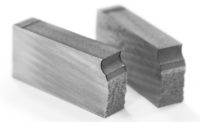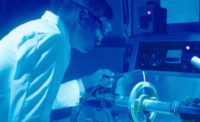Complex advances in metallic and non-metallic manufacturing deliver real value for key stakeholders involved in the aerospace industry. The requirement for original equipment manufacturers (OEMs) to deliver lighter, stronger and more durable and damage-tolerant airframes powers this growth forward. It means innovative solutions have been developed through improvements to metallic alloys, as well as breaking new ground in the creation of new non-metallic composite materials. But as more is demanded from these materials, and as new types of materials are being created, assessing and characterizing their properties to predict their failure becomes more challenging.
TECH TIPSThe significant growth in non-metallic composites has been identified as a real game-changer within the aerospace industry. By leveraging the benefits of vastly reduced weight that is also highly durable, when compared with metallic equivalents, composites offer viable options for primary construction materials. Given the speed of advances in this area, new materials with new properties are being created at a very fast rate. |
What is particularly significant in the race for fuel efficiency delivered by lighter components is the interplay between metallics and non-metallics, with a real race going on. Short-to-medium term gains are set to be made from advances in metallics, such as titanium and aluminum-lithium alloys. However, there is the potential for the eventual ascendancy of non-metallic composite materials, as their properties become more easily predicted and characterized. Whatever these comparative advances, it is not enough to merely know the basic properties of a material, so durability and damage tolerance (D&DT) is crucial.
All aerospace vehicles must be designed to be durable and damage tolerant (DT). Durability is an economic life-cycle design consideration whereas DT relates to a structure’s ability to safely sustain defects until they are removed or repaired. DT is based on the assumption that undetectable cracks that grow during service are present in each fracture critical component at the most critical location. Hence, OEMs use fracture mechanics (FM) methods to help design the aircraft. Fracture mechanics is the study of crack propagation in materials and relies on fatigue crack propagation (FCP) and fracture toughness (FT) testing. When a material is subjected to repeated loading and unloading, fatigue occurs. Fatigue crack propagation measures fatigue crack growth rate versus change in crack tip stress intensity. When a crack grows to a critical size, it has reached its critical fracture toughness or stress intensity and catastrophic failure occurs. In general terms, durability relates to FCP and damage tolerance relates to fracture toughness.
There is much experience and data for fracture mechanics testing of aluminum and titanium alloys used in the aerospace sector. However, use of non-metallic composite materials in up to over 50% of large commercial airliners, such as the Boeing Dreamliner, is a significant new development. The D&DT requirement is particularly challenging for non-metallic composites since they are not as isotropic and lack ductility compared to aluminum aerospace alloys. Moreover, crack growth and failure mechanisms of non-metallic composite structures are not as well understood and cannot be predicted accurately. Hence, current design and analysis methods should rely heavily on FM testing to compare with predictions and to build a sizeable database.
The Importance of Fracture Mechanics (FM) Testing
Most aircraft structural failures are due to fatigue crack growth leading up to catastrophic failure. As a result, FM testing forms an important part of the advancement of the aerospace industry allowing OEMs to rely on tougher, newly developed materials more resistant to crack growth.
FM testing is crucial to assessing the viability of a particular material for use in a given component. What is at stake is learning the D&DT of a material or structure, and the ways that the material or structure can fail. There exists a range of tests to examine FM, such as FCP and FT testing, which have critical applications in the aerospace industry.
We know that some properties of metallic aerospace materials change with increased use. Deterioration such as corrosion affects the life and fatigue resistance of aluminum aerospace alloys whereas creep and low cycle fatigue lower the life of metallic engine components. However, our knowledge on deterioration of composites with use is limited. This leads to the need for more extensive FM testing to determine, for example, how salt water will affect crack growth in composites.
The importance of high-quality and efficient FM testing cannot be underestimated. As we see innovations such as the move to primary structures made from composites, we need to understand the life cycle to predict and weigh the future costs of use. Therefore, exploring the viability of new alloys and new composite materials going forward will shape the direction of aerospace manufacturing and material testing.
FM Testing of New Alloys and Processes
In order to be in a position to alter the make-up of a given alloy to ensure it is fit for purpose, it is crucial to conduct a battery of FM tests at a range of atmospheres, spectra and temperatures to deliver optimal results. It is typical in alloy development that when one property increases, another decreases. Hence, as new alloys are created, new behaviors will need to be tested. Flexibility is critical as the alloy development process is responsive and slight changes to the base alloy and heat treatment have to be made and then tested when looking to get the desired response of the new alloy.
One process of new metallic manufacturing that is set to deliver gains is additive manufacturing. Additive manufacturing techniques are expected to provide a range of new opportunities within aerospace manufacturing. However, as innovation in additive manufacturing continues, newly developed processes will effectively develop into new sub-sections, requiring expanded investment and more niche testing. And while it is important to find the FM properties of alloys, it is equally important to test different processes. This is because the process, rather than the alloy’s chemical composition, can be the key reason for a given type of failure.
FM Testing of New Composite Materials
The significant growth in non-metallic composites has been identified as a real game-changer within the aerospace industry. By leveraging the benefits of vastly reduced weight that is also highly durable, when compared with metallic equivalents, composites offer viable options for primary construction materials. However, the new materials and new processes are causing new failures. Without investment in FM testing, organizations will not get the returns required.
Given the speed of advances in this area, new materials with new properties are being created at a very quick rate. The data available on the properties of these materials is therefore lacking. In addition, FM testing of composite materials is more difficult and complex due to issues such as alignment and buckling. This means that more advances in FT testing technology are required when compared with metallics.
It is expected that demand for ceramic matrix composites (CMCs) will increase tenfold over the next decade, according to estimates from GE. CMCs, which are capable of withstanding temperatures of up to 3,000°F and delivering unprecedented performance gains within aero engines, have attracted significant attention. CMCs can be seen in the CFM International LEAP high-bypass turbofan engine, currently being developed in a joint venture between GE and Snecma, intended for use in the Airbus A320neo, the Boeing 737 MAX and China’s COMAC C919 aircraft by 2017.
With such advances come a range of challenges within FM testing of these materials. For example, in comparison with the testing of alloys, there are a far larger number of unknowns when it comes to the characteristics of composites and the way they fail. There are also additional challenges when working with new composite materials. The importance of material-specific approaches to storage, production, machining and preparation of each composite must be emphasized. For example, if a sample of composite material is cut misaligned, its fibers can materially change, impacting testing in ways unnoticeable until results are evaluated. Also, due to the nature of the fiber-based material that is stronger and stiffer but consequently more brittle, it cannot be fatigue tested for crack growth in the same way as alloys; different fixtures and speeds are necessary.



